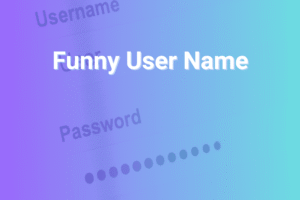In a world where social media trends rise and fade in the blink of an eye, one viral challenge has stood out by spreading pure laughter and connection — the What’s Your Name Game Funny. This playful trend blends humour, creativity, and individuality, offering a refreshing break from the usual online noise. It turns something as simple as your name into a hilarious identity that’s impossible not to share.
The magic lies in its simplicity. By combining your name with random adjectives, scenarios, or themes, you get a unique, funny title that feels personal and entertaining. From TikTok reels to classroom boards, this lighthearted challenge has captured hearts everywhere, proving that humour remains one of the strongest forms of digital connection.
What’s your name game funny?
It is a viral challenge that turns your name into a hilarious, customised phrase or identity using playful word combinations. It’s funny, creative, and deeply relatable — people love sharing their results online for laughs and connection.
The Viral Rise of the Internet’s Funniest Name Trend
The internet has a unique way of transforming the simplest ideas into global sensations, and this playful naming challenge is the perfect example. What began as a small interactive post quickly evolved into a cultural phenomenon, spreading through memes, videos, and social challenges across every major platform.
The viral wave can be traced back to TikTok, where short-form humour thrives. A few creative users began mixing names with funny adjectives and random scenarios. For instance, a video might say, “Type the first letter of your name to discover your funny title!” The chart would include combinations like “A = Awkward,” “B = Bubbly,” “C = Clumsy,” paired with endings such as “dancing with penguins” or “eating tacos.” Viewers loved seeing what their name revealed, and soon, everyone wanted to join in.
The magic behind the trend lies in its simplicity and participation. Each person’s result feels personalised, sparking laughter and curiosity among friends. Whether it’s a teen scrolling TikTok or a teacher using it in class, the activity connects people through humour and creativity. Every shared result encourages others to try it too, creating an endless feedback loop of engagement.
Some creators even merged it with other naming games, turning it into a humorous generator for car names, pet nicknames, or fantasy identities. This blend of ideas made the trend even more dynamic and shareable, keeping audiences entertained and coming back for more.
Experts in digital psychology suggest that such viral trends succeed because they merge identity with playfulness. They allow people to express themselves in a lighthearted way, breaking away from the overly polished, curated content common online. It’s simple, spontaneous, and fun — qualities that make it irresistibly relatable.
Another major reason for its explosive growth is accessibility. There are no apps to install or complicated rules to follow — just your name, a chart, and a sense of humour. This made it easy for users everywhere to participate, helping the trend leap from TikTok to Instagram, YouTube Shorts, Facebook Reels, and even casual WhatsApp group chats.
Make Your Own Hilarious Name Challenge Online
This viral naming challenge turns ordinary names into hilarious identities using creative combinations of letters, themes, and scenarios. It’s simple, funny, and endlessly shareable.
Understand the Core Concept
At its heart, what’s your name game funny uses simple name-letter combinations to generate humorous outcomes. It can follow formats like “first letter + adjective + scenario” or “birth month + action + animal.” For example, the letter “J” might stand for “Jumpy,” and if your birth month is March, you might get “Jumpy March Monkey.” Instantly funny and personalised!
Choose a Theme
Themes make the game even more entertaining. You can base it on superheroes, fantasy kingdoms, foods, or even moods. A fantasy version might turn your name into something like “Sir Sneaky Sebastian of Sandwich Kingdom.” Try incorporating a kingdom name generator to create unique fantasy worlds that add extra humour and creativity.
Build a Chart or Formula
Write out 26 funny adjectives (A–Z) and 12 scenarios or objects (for months). Pair them together randomly. For instance:
A = Awkward, B = Brave, C = Crazy
January = dancing with dragons, February = eating too much cheese
Now, combine them: “Crazy February” becomes “Crazy eating too much cheese!” It’s chaotic and hilarious — the essence of what’s your name game funny.
Share and Tag Friends
Post your result on social media and tag friends. The secret ingredient behind this trend’s success is participation. The moment you tag friends, they play too, tagging others. Within days, your post can become part of a larger viral chain.
Why This Viral Name Challenge Is So Addictive
This viral name challenge captivates millions with its mix of humour, curiosity, and instant gratification. It’s simple, fun, and deeply satisfying to share.
- It triggers curiosity: Everyone wants to know what their “funny name” will be. The mystery keeps them scrolling.
- It builds anticipation: The reveal moment provides instant satisfaction.
- It feels personal: People love seeing themselves in content — this trend literally puts your name in the spotlight.
- It’s socially rewarding: Posting your result and seeing others react gives validation and belonging.
- It’s creative but easy: No special skill needed — just your imagination.
- It delivers instant joy: Laughing at your funny result releases dopamine, making you want to play again.
- It reduces anxiety: Harmless humour gives mental relief from stressful online content.
- It spreads positivity: It’s rare for viral trends to be wholesome, but this one unites people through laughter, not conflict.
The Cultural Power Behind a Viral Naming Trend
Beyond simple humour, this viral naming challenge represents something deeper about digital culture — the universal desire to express individuality within shared online experiences. In an era where algorithms often encourage uniformity, it stands out by celebrating creativity and personal expression through a common framework.
Teachers have embraced it as a fun icebreaker activity that builds connection in classrooms. Marketers use it to spark audience engagement and social participation. YouTubers have turned it into multi-part challenges, while families include it in game nights for laughter and bonding. The trend crosses language, geography, and age barriers — with people around the world creating local adaptations that perfectly suit their cultural humour.
What’s most fascinating is how this phenomenon mirrors the evolution of internet comedy itself. Today’s memes thrive on unpredictability, absurdity, and inclusivity — all qualities that this game embodies. It captures the essence of Gen Z humour: self-aware, spontaneous, and delightfully random, proving that even the simplest ideas can unite millions through shared laughter.
Themed Versions of the Viral Name Challenge Craze
From fantasy-inspired names to food-themed hilarity, creative variations keep this viral name challenge exciting. Each twist adds new humour and endless replay value.
Themed Editions
Different themes keep the trend alive. You can have:
Superhero Edition: “Mighty Max the Masked Muffin.”
Animal Edition: “Lazy Leo the Lion of Laughter.”
Fantasy Edition: “Sir Sebastian of Sandwich Kingdom.”
Food Edition: “Bubbly Brenda Burrito Queen.”
Group Fun
The game works wonderfully in group settings. Teachers start classes with it to warm up students. Offices use it to add humour to team meetings. It breaks the ice, builds smiles, and sets a positive tone.
Online Challenges
Creators use hashtags like #whatsyournamegamefunny and #funnynamechallenge to invite audiences to join. This engagement helps content reach millions of views in hours.
Conclusion
This viral naming trend goes beyond being just another fleeting internet joke — it’s a reflection of how creativity and humour can unite people across cultures and generations. In an online world often dominated by serious content, it brings back pure, unfiltered joy. It reminds us that laughter, when shared, becomes a universal language that transcends screens and social platforms.
What makes it truly special is its personal touch. Turning a simple name into a playful identity transforms interactions into shared experiences and memories. From classroom icebreakers to viral TikTok challenges, this trend continues to bridge gaps between strangers, families, and communities — proving that in the age of digital connection, a little humour still goes a long way.
FAQ’s
Who started the trend?
While no single creator officially claims ownership, the trend began on TikTok as a lighthearted naming challenge. Its humorous format and shareable nature helped it spread rapidly across multiple social platforms, inspiring countless remixes and variations.
How can I create my own version?
Start by using funny adjective charts, name generators, or scenario-based prompts. Combine these with creative themes or AI filters to make your version stand out. The key is to balance simplicity with humour so anyone can join in easily.
Is it safe for kids?
Yes, it’s completely family-friendly and suitable for all age groups. Parents, teachers, and event hosts often use it to bring laughter and creativity into classrooms, birthday parties, or social gatherings in a safe, positive way.
Why do people love it so much?
Because it’s easy, funny, and interactive — everyone enjoys discovering their unique “name” and sharing it with friends. It blends humour, surprise, and self-expression, making it one of the most universally enjoyable online challenges.
Can brands or teachers use it?
Absolutely. Teachers use it as a classroom icebreaker to encourage participation, while marketers and brands leverage it to boost engagement and audience interaction. Its versatility and viral appeal make it ideal for educational and promotional use alike.










